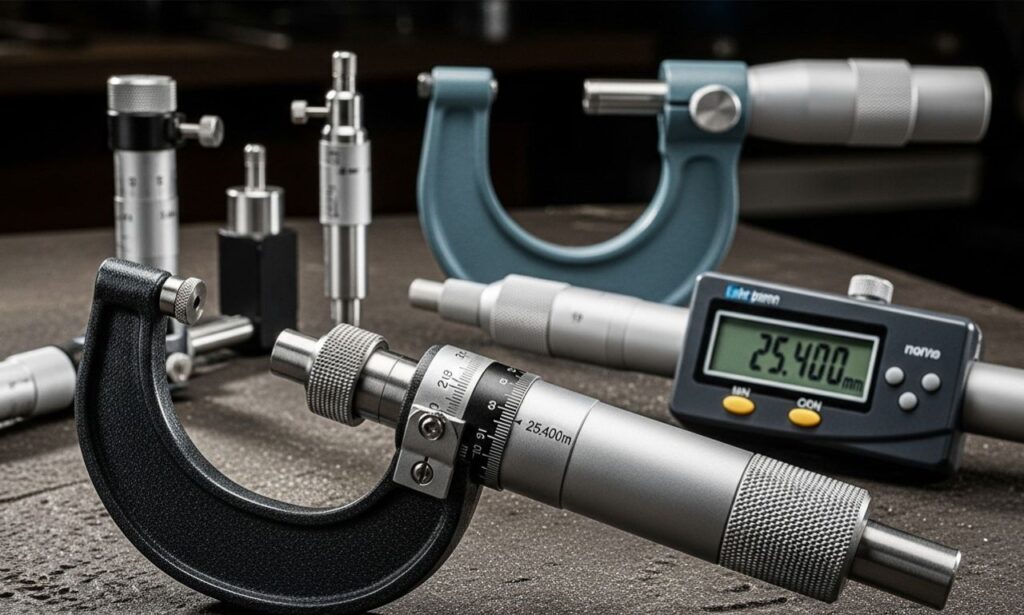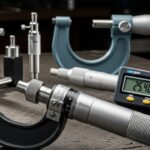When it comes to precision in measurement, few tools can rival the micrometer. This small yet mighty instrument is a staple in workshops and laboratories around the world. Whether you’re an engineer, machinist, or simply someone who values accuracy, understanding micrometers can elevate your measuring game significantly. Imagine being able to measure with such exactness that even the tiniest fractions of a millimeter are clear as day! In this post, we’ll dive into what makes micrometers essential for precision measurements and explore their various types, uses, and maintenance tips. Get ready to unlock the potential of this indispensable tool!
What is Micrometers?
A micrometer is a precision instrument used to measure small distances or thicknesses with remarkable accuracy. Often referred to as a “mic” or “micrometer screw gauge,” it can provide measurements down to one-thousandth of a millimeter.
This tool operates on the principle of a calibrated screw, converting rotational movement into linear measurement. A micrometer typically features a movable spindle that closes against the object being measured and an accompanying scale for reading results.
Commonly found in workshops and laboratories, this device is crucial for engineering, metalworking, and woodworking applications. Its ability to deliver precise readings makes it indispensable for quality control in manufacturing processes.
Micrometers come in various forms tailored for specific uses, including external micrometers for measuring outside dimensions and internal micrometers designed for internal diameters. Each type serves its purpose efficiently while ensuring accurate results every time.
The different types of micrometers
Micrometers come in various types, each designed for specific measurement tasks. The most common type is the outside micrometer, ideal for measuring external dimensions of objects like rods or sheets.
Then there’s the inside micrometer. This tool excels at gauging internal diameters, perfect for tasks such as measuring holes or tubing.
Depth micrometers are another essential variant. They measure the depth of slots or grooves effectively. With a flat surface and a calibrated rod, they provide precise readings.
For more specialized needs, digital micrometers have gained popularity. These offer electronic readouts that simplify data collection and reduce human error.
There are special-purpose micrometers tailored for unique applications—like wire or blade thicknesses—ensuring no measurement task goes unaddressed. Each type brings its strengths to the table, making precision possible across different fields.
How to read and use a micrometer
Reading and using a micrometer is straightforward once you familiarize yourself with its components. The main parts include the frame, anvil, spindle, thimble, and ratchet.
To start measuring, place the object between the anvil and spindle. Gently close the spindle until it touches the object but avoid applying excessive pressure.
Now it’s time to read your measurement. Look at where the thimble aligns with the scale on the sleeve. The whole number comes from the sleeve’s scale while any additional reading can be found on the thimble.
If your micrometer has a ratchet mechanism, use it for consistent pressure during measurements. This feature ensures accuracy by preventing over-tightening.
With practice, interpreting readings will become second nature! Just remember that precision is key in every measurement you take.
The importance of precision measurements in various industries
Precision measurements play a critical role across numerous industries. In manufacturing, even the slightest error can lead to faulty products. Ensuring that parts fit together perfectly is essential for quality control.
In aerospace, precision is non-negotiable. Components must withstand extreme conditions, and accurate measurements are vital for safety and performance.
Medical devices also require exact specifications to function correctly. A small miscalculation could jeopardize patient health or compromise the effectiveness of treatments.
The automotive industry relies on precise measurements for engine components and safety features. These details directly impact vehicle performance and driver safety.
Even in construction, where structural integrity is key, accuracy ensures buildings meet design standards. This prevents costly reworks and enhances overall project efficiency.
Across all these fields, tools like micrometers make achieving high precision feasible. Their reliability supports innovation while maintaining rigorous quality standards.
Advantages of using micrometers over other measuring tools
Micrometers offer unparalleled accuracy, making them a go-to choice for precision measurements. Unlike rulers or tape measures, which can lead to substantial errors, micrometers provide readings down to the thousandths of a millimeter.
The design of a micrometer allows it to measure small dimensions with ease. Its screw mechanism translates small rotations into large movements, enabling users to achieve tighter tolerances.
Another significant advantage is consistency. Micrometers minimize user error through their standardized operation. This reliability is crucial in fields like engineering and manufacturing, where even minor discrepancies can have major consequences.
Durability is yet another benefit. Crafted from robust materials like steel or carbide, these tools withstand wear over time while maintaining their accuracy.
When you need precision that other measuring instruments can’t match, a micrometer stands out as an invaluable resource in any toolkit.
Tips for maintaining and calibrating your micrometer
To ensure the longevity and accuracy of your micrometer, regular maintenance is key. Start by keeping it clean. Use a soft cloth to wipe away any dust or debris after each use. Avoid harsh chemicals that can damage the surface.
Calibration is equally important. Check your micrometer against a known standard periodically to confirm its accuracy. If you notice discrepancies, adjust accordingly or seek professional calibration services.
Store your micrometer in a protective case when not in use to prevent physical damage. Keeping it at room temperature helps maintain precision, as extreme temperatures can affect measurements.
Handle with care; avoid dropping or knocking it against hard surfaces. A gentle approach goes a long way in preserving its functionality over time. Adopting these habits ensures reliable performance whenever you need precise measurements.
Why every workshop or laboratory should have a micrometer
Every workshop or laboratory thrives on precision. A micrometer is indispensable in achieving that accuracy. Whether you’re working with metals, wood, or other materials, the need for exact measurements cannot be overstated.
Imagine crafting a component where even a fraction of a millimeter can lead to failure. This tool ensures you get it right every time.
A micrometer allows for easy measurement of small dimensions that calipers simply can’t manage with the same level of detail. Its design offers both simplicity and effectiveness, making it user-friendly.
Moreover, having a micrometer fosters consistency in production processes. It helps maintain quality control by ensuring all parts meet specified tolerances.
Investing in this tool means investing in reliability and excellence across various projects. Every professional knows that precision counts; having a micrometer at hand makes sure you never compromise on that front.
Conclusion
Micrometers are more than just tools; they embody precision and accuracy in measurement. Their significance spans across various industries, from manufacturing to scientific research. Understanding the different types of micrometers and how to read them enhances your ability to make precise measurements easily.
The advantages of using a micrometer over other measuring instruments cannot be overstated. The level of detail they provide is unmatched, making them indispensable for anyone who values accuracy in their work. Regular maintenance and calibration ensure that your micrometer remains reliable, enhancing its longevity and performance.
Every workshop or laboratory should consider having a micrometer as part of their essential toolkit. With the right knowledge and care, this tool can elevate your measurement capabilities significantly. Whether you’re an engineer, machinist, or hobbyist, incorporating a micrometer into your practice will undoubtedly lead to improved results in all precision tasks you undertake.






